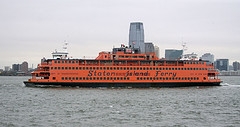Coastal Smart Growth Home: Element 8
ELEMENT 8:
Provide a variety of land- and water-based transportation options
Smart Growth Principle
Giving people more options for getting around meets many community goals. When people find it easy and safe to walk, bike, or take transit, they no longer have to rely exclusively on cars to get to shops, work, and school, reducing air pollution and traffic congestion. Walking and biking also help people include physical activity in their daily routines, give more freedom to those unable or unwilling to drive, and can reduce household transportation costs.
Coastal and Waterfront Context
While waterfront and coastal communities share many of the transportation-related concerns faced by inland communities, their proximity to water creates distinct transportation challenges as well as opportunities. All communities wrestle with traffic congestion; in waterfront communities, this congestion can be exacerbated by local topography, bridges, surges in seasonal visitors and part-year residents, and the hub-and-spoke nature of marine-based freight movement. Parking can be a challenge in any vibrant economic center; seasonal and weekend waterfront visitors or part-year residents compound that challenge.
Tools & Techniques
Coastal and waterfront communities, though, can offer water-based transportation options, such as ferries and water taxis, that are unavailable to their landlocked counterparts. When combined with higher density, mixed-use, transit-oriented development on the waterfront, water-based transportation becomes more attractive to both tourists and commuters. The Washington State ferry system, the largest in the country, serves more than 26 million people per year with 20 terminals throughout Puget Sound. The ferry system has reduced automobile use in the region, in part because of developments like the Bremerton Harborside project. This high-density, mixed-use redevelopment connects the ferry terminal to homes, stores, and other places and makes better use of valuable waterfront land than its previous incarnation: parking lots for ferry riders. Elsewhere, Baltimore, Maryland's water taxi system, the oldest in the country, benefits from its connections to the redeveloped Inner Harbor, which attracts tourists and houses permanent residents and workers. The Baltimore water taxi service provides access to more than 30 attractions and neighborhoods for tourists (and, increasingly, commuters) across the city. Smaller watercraft can be viable transportation alternatives, too. Communities such as Seattle are adding blue trails for recreational and commuter kayaking. In Seattle, the Lakes-to-Locks Water Trail connects inland lakes, rivers, waterways, and the ship canal with the shores of Elliot Bay and Puget Sound. Baltimore's Canton Kayak Club maintains four docks with boats, paddles, and life vests around the harbor, and some club members use the boats to paddle to work.
When appropriately connected, water-based transportation options also can strengthen the value and utility of ground transit (such as buses, subways, commuter trains, and streetcars). Boston's Massachusetts Bay Transportation Authority operates commuter boats and ferries with many destinations and with connections to subway lines, commuter rail lines, and bus routes, making transfers and trip planning easier for residents and visitors.
Other tools to improve transportation options apply to both waterfront and inland settings. These tools include variable pricing that charges higher fees during peak demand, and convenient park-once or shared parking facilities with good shuttle or walking connections to desired destinations (see Element 4 for more information on walkable communities). Locating parking facilities away from the water's edge can free valuable waterfront land for development or water access. Other system-wide investments in reliable public transit (including buses or streetcars), improved connectivity among road networks, and better infrastructure for biking and walking can help make alternatives to driving easier and more appealing.
Providing a wide range of land- and water-based transportation options can help communities by the water create a welcoming, pedestrian-friendly environment that also accommodates the efficient movement of goods necessary to waterfront commerce.
| Key Action Options | Policies, Tools, and Techniques for Implementation |
|---|---|
Enhance water-based public transportation and link it to pedestrian and land-based transit systems
|
|
Ensure that transportation options consider the movement of goods, as well as people |
|
Plan for seasonal transportation needs |
|

The Staten Island Ferry provides a water-based transportation option for 65,000 passengers daily, reducing congestion in the bridges and tunnels that provide access to Manhattan and reducing associated pollution. Courtesy: Mike Powell / CC BY-SA 2.0
Case Study: The Staten Island Ferry, New York
Every year, the Staten Island Ferry gives more than 19 million passengers-including commuters, residents, and tourists-a ride across New York Harbor between Staten Island and lower Manhattan. The ferry runs 24 hours a day, every day of the year. Operated by New York City as a municipal service since 1905, the ferry serves 65,000 passengers on a typical weekday and is open to pedestrians only. Rail and bus service is available at both ferry terminals; the Staten Island Terminal is served by multiple buses and the Staten Island Railway, while the Whitehall Terminal in Manhattan is within walking distance of the city subway and three bus lines. According to New York City's Independent Budget Office, about 40,000 weekday trips are made on the ferry by Staten Island residents, equivalent to roughly 20,000 two-way commuter trips a day across the two bridge and tunnel routes into lower Manhattan. Given that a typical bridge or tunnel lane can accommodate about 6,000 vehicles during peak rush hours, the ferry has helped to reduce congestion, as well as the need for investment in additional lane capacity.

